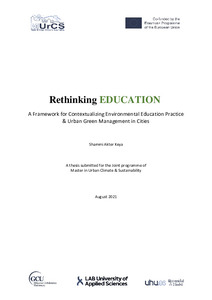Rethinking Education : A framework for contextualizing environmental education practice & urban green management in cities
Keya, Shammi Akter (2021)
Keya, Shammi Akter
2021
Julkaisun pysyvä osoite on
https://urn.fi/URN:NBN:fi:amk-2021101318621
https://urn.fi/URN:NBN:fi:amk-2021101318621
Tiivistelmä
The worldwide Education system is going through continuous changes since evolution due to changes in strategies for survival. While the traditional idea of Education inclines towards indoor-based learning, the emerging stress on outdoor Education to connect students with local nature increases the potential of climate-responsive Education. Educating people to grow as 'environmentally aware citizens' can also boost their active participation and help cities grow sustainably. Different cities around the world (e.g., Lahti, Kyoto, Oki Islands, Glasgow) have adopted 'Outdoor Education' (OE) and 'Environmental Education' (EE) as tools for sustainable development in cities with the collaboration of local communities. However, the scope for outdoor Environmental Education can vary largely in different cities. The majority of cities worldwide are lagging in incorporating local green spaces purposefully, especially in densely built cities (e.g., Dhaka, Bangladesh).
Moreover, the multiple health benefits related to urban green areas, including enhancing local climate and reducing Attention-deficit hyperactivity disorder (ADHD) at an early age, have put more stress on green management in urban areas. This research focuses on reviewing the potential of Environmental Education Practice (EEP) as an Urban Green (UG) management tool in different cities. The study critically analyzes existing practices in other cities to understand EEP's socio-economic and environmental impact while exploring students' perceptions of the local environment. This analysis helps understand whether contextual differences, even within city-scale, can or cannot impact pro-environmental behaviours and willingness for outdoor Educational activities. Analyzing students' responses and contextual morphology of relative school neighbourhoods, one in densely built-up areas and one in greener areas in Lahti and Dhaka, helped identify critical urban built and natural indicators to develop the School Criticality Index (SCI). The proposed SCI helps distinguish schools based on their contextual differences within a city and suggests interventions related to greening within school neighbourhoods for optimized EEP. The proposed SCI can help researchers, practitioners, and policymakers identify factors affecting lesser or more EEP potential in different contexts, focus on where to increase greeneries, and integrate schools with Urban Green (UG) management through climate resilience Education.
Moreover, the multiple health benefits related to urban green areas, including enhancing local climate and reducing Attention-deficit hyperactivity disorder (ADHD) at an early age, have put more stress on green management in urban areas. This research focuses on reviewing the potential of Environmental Education Practice (EEP) as an Urban Green (UG) management tool in different cities. The study critically analyzes existing practices in other cities to understand EEP's socio-economic and environmental impact while exploring students' perceptions of the local environment. This analysis helps understand whether contextual differences, even within city-scale, can or cannot impact pro-environmental behaviours and willingness for outdoor Educational activities. Analyzing students' responses and contextual morphology of relative school neighbourhoods, one in densely built-up areas and one in greener areas in Lahti and Dhaka, helped identify critical urban built and natural indicators to develop the School Criticality Index (SCI). The proposed SCI helps distinguish schools based on their contextual differences within a city and suggests interventions related to greening within school neighbourhoods for optimized EEP. The proposed SCI can help researchers, practitioners, and policymakers identify factors affecting lesser or more EEP potential in different contexts, focus on where to increase greeneries, and integrate schools with Urban Green (UG) management through climate resilience Education.
